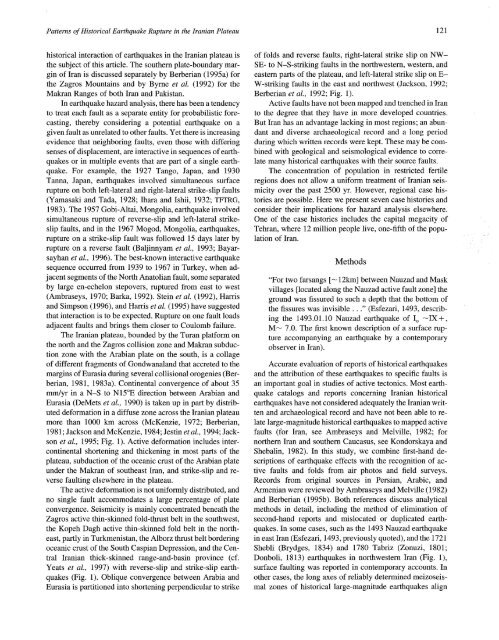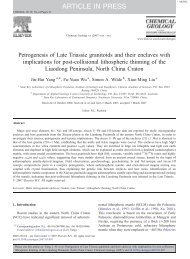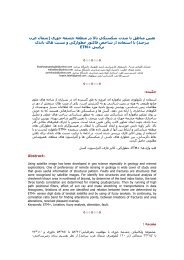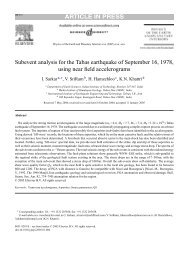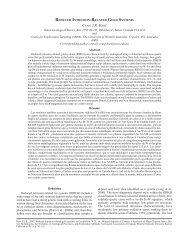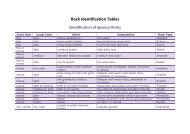Patterns of Historical Earthquake Rupture in the Iranian Plateau
Patterns of Historical Earthquake Rupture in the Iranian Plateau
Patterns of Historical Earthquake Rupture in the Iranian Plateau
- No tags were found...
You also want an ePaper? Increase the reach of your titles
YUMPU automatically turns print PDFs into web optimized ePapers that Google loves.
<strong>Patterns</strong> <strong>of</strong> <strong>Historical</strong> <strong>Earthquake</strong> <strong>Rupture</strong> <strong>in</strong> <strong>the</strong> <strong>Iranian</strong> <strong>Plateau</strong> 121historical <strong>in</strong>teraction <strong>of</strong> earthquakes <strong>in</strong> <strong>the</strong> <strong>Iranian</strong> plateau is<strong>the</strong> subject <strong>of</strong> this article. The sou<strong>the</strong>rn plate-boundary marg<strong>in</strong><strong>of</strong> Iran is discussed separately by Berberian (1995a) for<strong>the</strong> Zagros Mounta<strong>in</strong>s and by Byrne et al. (1992) for <strong>the</strong>Makran Ranges <strong>of</strong> both Iran and Pakistan.In earthquake hazard analysis, <strong>the</strong>re has been a tendencyto treat each fault as a separate entity for probabilistic forecast<strong>in</strong>g,<strong>the</strong>reby consider<strong>in</strong>g a potential earthquake on agiven fault as unrelated to o<strong>the</strong>r faults. Yet <strong>the</strong>re is <strong>in</strong>creas<strong>in</strong>gevidence that neighbor<strong>in</strong>g faults, even those with differ<strong>in</strong>gsenses <strong>of</strong> displacement, are <strong>in</strong>teractive <strong>in</strong> sequences <strong>of</strong> earthquakesor <strong>in</strong> multiple events that are part <strong>of</strong> a s<strong>in</strong>gle earthquake.For example, <strong>the</strong> 1927 Tango, Japan, and 1930Tanna, Japan, earthquakes <strong>in</strong>volved simultaneous surfacerupture on both left-lateral and fight-lateral strike-slip faults(Yamasaki and Tada, 1928; Ihara and Ishii, 1932; TFTRG,1983). The 1957 Gobi-Altai, Mongolia, earthquake <strong>in</strong>volvedsimultaneous rupture <strong>of</strong> reverse-slip and left-lateral strikeslipfaults, and <strong>in</strong> <strong>the</strong> 1967 Mogod, Mongolia, earthquakes,rupture on a strike-slip fault was followed 15 days later byrupture on a reverse fault (Balj<strong>in</strong>nyam et al., 1993; Bayarsayhanet al., 1996). The best-known <strong>in</strong>teractive earthquakesequence occurred from 1939 to 1967 <strong>in</strong> Turkey, when adjacentsegments <strong>of</strong> <strong>the</strong> North Anatolian fault, some separatedby large en-echelon stepovers, ruptured from east to west(Ambraseys, 1970; Barka, 1992). Ste<strong>in</strong> et al. (1992), Harrisand Simpson (1996), and Harris et al. (1995) have suggestedthat <strong>in</strong>teraction is to be expected. <strong>Rupture</strong> on one fault loadsadjacent faults and br<strong>in</strong>gs <strong>the</strong>m closer to Coulomb failure.The <strong>Iranian</strong> plateau, bounded by <strong>the</strong> Turan platform on<strong>the</strong> north and <strong>the</strong> Zagros collision zone and Makran subductionzone with <strong>the</strong> Arabian plate on <strong>the</strong> south, is a collage<strong>of</strong> different fragments <strong>of</strong> Gondwanaland that accreted to <strong>the</strong>marg<strong>in</strong>s <strong>of</strong> Eurasia dur<strong>in</strong>g several collisional orogenies (Berberian,1981, 1983a). Cont<strong>in</strong>ental convergence <strong>of</strong> about 35mm/yr <strong>in</strong> a N-S to N15°E direction between Arabian andEurasia (DeMets et al., 1990) is taken up <strong>in</strong> part by distributeddeformation <strong>in</strong> a diffuse zone across <strong>the</strong> <strong>Iranian</strong> plateaumore than 1000 km across (McKenzie, 1972; Berberian,1981; Jackson and McKenzie, 1984; Jest<strong>in</strong> et al., 1994; Jacksonet al., 1995; Fig. 1). Active deformation <strong>in</strong>cludes <strong>in</strong>tercont<strong>in</strong>entalshorten<strong>in</strong>g and thicken<strong>in</strong>g <strong>in</strong> most parts <strong>of</strong> <strong>the</strong>plateau, subduction <strong>of</strong> <strong>the</strong> oceanic crust <strong>of</strong> <strong>the</strong> Arabian plateunder <strong>the</strong> Makran <strong>of</strong> sou<strong>the</strong>ast Iran, and strike-slip and reversefault<strong>in</strong>g elsewhere <strong>in</strong> <strong>the</strong> plateau.The active deformation is not uniformly distributed, andno s<strong>in</strong>gle fault accommodates a large percentage <strong>of</strong> plateconvergence. Seismicity is ma<strong>in</strong>ly concentrated beneath <strong>the</strong>Zagros active th<strong>in</strong>-sk<strong>in</strong>ned fold-thrust belt <strong>in</strong> <strong>the</strong> southwest,<strong>the</strong> Kopeh Dagh active th<strong>in</strong>-sk<strong>in</strong>ned fold belt <strong>in</strong> <strong>the</strong> nor<strong>the</strong>ast,partly <strong>in</strong> Turkmenistan, <strong>the</strong> Alborz thrust belt border<strong>in</strong>goceanic crust <strong>of</strong> <strong>the</strong> South Caspian Depression, and <strong>the</strong> Central<strong>Iranian</strong> thick-sk<strong>in</strong>ned range-and-bas<strong>in</strong> prov<strong>in</strong>ce (cf.Yeats et al., 1997) with reverse-slip and strike-slip earthquakes(Fig. 1). Oblique convergence between Arabia andEurasia is partitioned <strong>in</strong>to shorten<strong>in</strong>g perpendicular to strike<strong>of</strong> folds and reverse faults, right-lateral strike slip on NW-SE- to N-S-strik<strong>in</strong>g faults <strong>in</strong> <strong>the</strong> northwestern, western, andeastern parts <strong>of</strong> <strong>the</strong> plateau, and left-lateral strike slip on E-W-strik<strong>in</strong>g faults <strong>in</strong> <strong>the</strong> east and northwest (Jackson, 1992;Berberian et al., 1992; Fig. 1).Active faults have not been mapped and trenched <strong>in</strong> Iranto <strong>the</strong> degree that <strong>the</strong>y have <strong>in</strong> more developed countries.But Iran has an advantage lack<strong>in</strong>g <strong>in</strong> most regions; an abundantand diverse archaeological record and a long perioddur<strong>in</strong>g which written records were kept. These may be comb<strong>in</strong>edwith geological and seismological evidence to correlatemany historical earthquakes with <strong>the</strong>ir source faults.The concentration <strong>of</strong> population <strong>in</strong> restricted fertileregions does not allow a uniform treatment <strong>of</strong> <strong>Iranian</strong> seismicityover <strong>the</strong> past 2500 yr. However, regional case historiesare possible. Here we present seven case histories andconsider <strong>the</strong>ir implications for hazard analysis elsewhere.One <strong>of</strong> <strong>the</strong> case histories <strong>in</strong>cludes <strong>the</strong> capital megacity <strong>of</strong>Tehran, where 12 million people live, one-fifth <strong>of</strong> <strong>the</strong> population<strong>of</strong> Iran.Methods"For two farsangs [-12km] between Nauzad and Maskvillages [located along <strong>the</strong> Nauzad active fault zone] <strong>the</strong>ground was fissured to such a depth that <strong>the</strong> bottom <strong>of</strong><strong>the</strong> fissures was <strong>in</strong>visible ..." (Esfezari, 1493, describ<strong>in</strong>g<strong>the</strong> 1493.01.10 Nauzad earthquake <strong>of</strong> IoM-- 7.0. The first known description <strong>of</strong> a surface ruptureaccompany<strong>in</strong>g an earthquake by a contemporaryobserver <strong>in</strong> Iran).Accurate evaluation <strong>of</strong> reports <strong>of</strong> historical earthquakesand <strong>the</strong> attribution <strong>of</strong> <strong>the</strong>se earthquakes to specific faults isan important goal <strong>in</strong> studies <strong>of</strong> active tectonics. Most earthquakecatalogs and reports concern<strong>in</strong>g <strong>Iranian</strong> historicalearthquakes have not considered adequately <strong>the</strong> <strong>Iranian</strong> writtenand archaeological record and have not been able to relatelarge-magnitude historical earthquakes to mapped activefaults (for Iran, see Ambraseys and Melville, 1982; fornor<strong>the</strong>rn Iran and sou<strong>the</strong>rn Caucasus, see Kondorskaya andShebal<strong>in</strong>, 1982). In this study, we comb<strong>in</strong>e first-hand descriptions<strong>of</strong> earthquake effects with <strong>the</strong> recognition <strong>of</strong> activefaults and folds from air photos and field surveys.Records from orig<strong>in</strong>al sources <strong>in</strong> Persian, Arabic, andArmenian were reviewed by Ambraseys and Melville (1982)and Berberian (1995b). Both references discuss analyticalmethods <strong>in</strong> detail, <strong>in</strong>clud<strong>in</strong>g <strong>the</strong> method <strong>of</strong> elim<strong>in</strong>ation <strong>of</strong>second-hand reports and mislocated or duplicated earthquakes.In some cases, such as <strong>the</strong> 1493 Nauzad earthquake<strong>in</strong> east Iran (Esfezari, 1493, previously quoted), and <strong>the</strong> 1721Shebli (Brydges, 1834) and 1780 Tabriz (Zonuzi, 1801;Donboli, 1813) earthquakes <strong>in</strong> northwestern Iran (Fig. 1),surface fault<strong>in</strong>g was reported <strong>in</strong> contemporary accounts. Ino<strong>the</strong>r cases, <strong>the</strong> long axes <strong>of</strong> reliably determ<strong>in</strong>ed meizoseismalzones <strong>of</strong> historical large-magnitude earthquakes align


